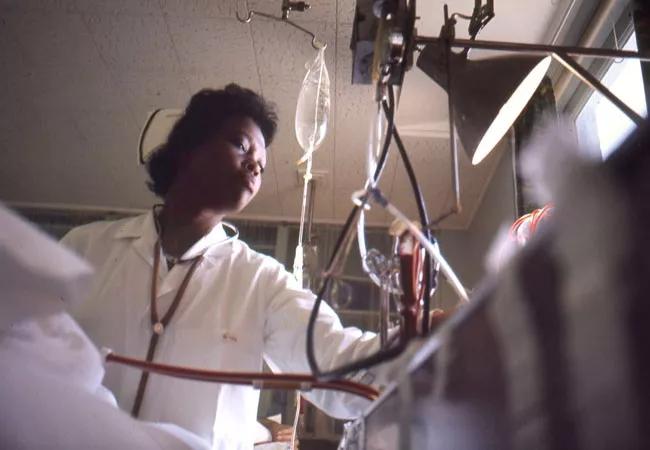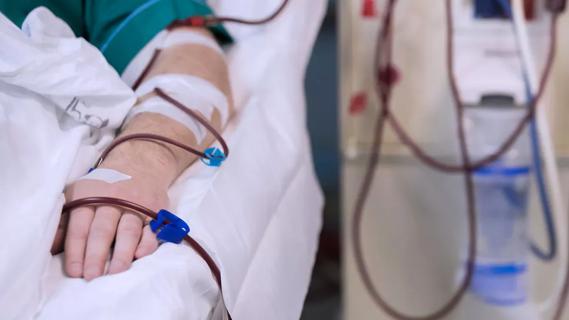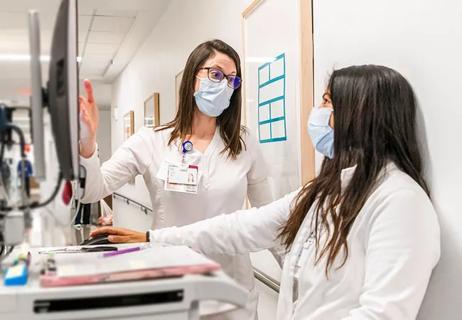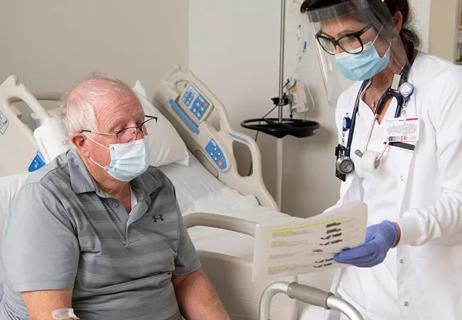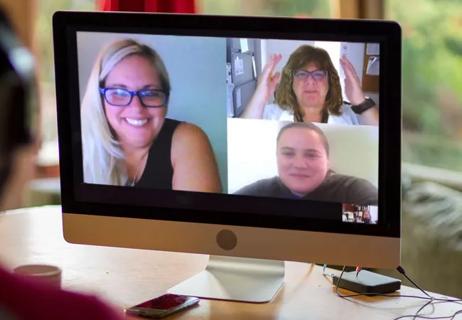By Meredith Foxx, MSN, MBA, APRN, PCNS-BC, PPCNP-BC, CPON, Executive Chief Nursing Officer
Advertisement
Cleveland Clinic is a non-profit academic medical center. Advertising on our site helps support our mission. We do not endorse non-Cleveland Clinic products or services. Policy
This month, Cleveland Clinic proudly celebrates its centennial anniversary. For 100 years, Cleveland Clinic has been providing high-quality care to patients – and nurses have been at the heart of that care from day one.
Cleveland Clinic’s four founders deeply respected nurses and valued their contributions to patient care. One founder, Frank E. Bunts, MD, remarked in a presentation, “I do recognize the splendid service that nurses have rendered in the past, and the constant obligations under which I have been to them for service to my patients, without whose aid I am sure such success as I have had would not be possible.”
Nurses have made significant contributions to clinical operations, professional practice, patient care, the overall advancement of healthcare and more. Today, with 28,000 nursing caregivers, the Cleveland Clinic Nursing Institute is recognized as one of the best nursing organizations in the world.
The following features a selection of Cleveland Clinic notable nursing highlights from the past 100 years.
The Early Years
- Cleveland Clinic’s first hospital included two houses. The Oxley Homes were named after superintendent Emma Oxley, an English-born nurse responsible for the day-to-day running of the hospital. Cleveland Clinic’s founders hired her to oversee the institution’s first inpatient facility, which had 53 beds.
- In June 1924, Cleveland Clinic opened a new, seven-floor, 184-bed hospital. (The Oxley Homes remained in service). Nurse Charlotte Dunning served as the hospital’s first Superintendent. Abbie Porter, the hospital’s first Superintendent of Nurses, succeeded Dunning as Superintendent in 1927.
- By March 1925, the hospital employed 61 nurses (including anesthetists), four postgraduate students, six female ward helpers, and eight male orderlies. Sixteen nurses and an orderly worked in the Oxley Homes. Several nurses served on the staff of the outpatient clinic, including the first head surgical nurse, Lillian Grundies.
- Tragically, on May 15, 1929, the basement of the hospital building caught fire and 123 people lost their lives; 43 were Cleveland Clinic employees.
The 1930s and 1940s
- By the early 1930s, the Superintendent of Nurses also served as the Assistant Superintendent of the Hospital. Nurse Elizabeth Hinds filled both roles until she resigned in 1934.
- As the United States entered World War II, the government recruited thousands of nurses for service. Cleveland Clinic recruited young women to train as nurses’ aides and to conduct routine work on the wards to allow nurses to concentrate on providing bedside care.
- In 1944, with many leaving for military service or industrial nursing positions in defense, nurses who stayed at Cleveland Clinic had a difficult and vital role. Only 50 registered nurses remained on staff — less than half as many as before the war — but outpatient visits and admissions were on the rise. The skill and dedication of hospital nurses made it possible to keep the hospital running at 94 percent.
- After the war, things slowly began to return to normal. An important change for nursing came in 1949, when Operating Room (OR) nursing, which had been part of the Department of Nursing, became a separate department. Elizabeth Pratt Graber, a long-time Cleveland Clinic nurse, was named acting head of the new department.
- The position of nurse’s aide evolved and was increasingly relied on to assist with patient care. By 1949, Cleveland Clinic had 42 full-time aides, compared to 24 in 1945.
The 1950s and 1960s
- In the 1950s, nursing gained organizational identity with the appointment of a nursing supervisor to handle administrative matters. Nurses served in two nurse-administered departments, as well as the physician-led Department of Anesthesiology. They were beginning to staff special care units, and other nursing programs (notably education and recruitment) expanded in scope and importance.
- Hospital patient care areas, traditionally referred to as “wards” or “floors,” became known as “nursing divisions” or “units” and included aides, senior aides, orderlies and hostess-clerks, in addition to registered nurses. Everyone worked together on tasks that were previously done almost exclusively by RNs. Practical nurses were hired for the first time.
- In 1958, practical nurses started being trained as surgical technical aides in the OR. Graduates of the six-month program filled the scrub nurse role under supervision of an RN circulating nurse.
- Rupert B. Turnbull, Jr., MD, a pioneer in colorectal surgery at Cleveland Clinic, hired Norma Gill-Thompson as the world’s first full-time enterostomal therapist. Together, they established the first enterostomal therapy training program.
- In 1969, Cleveland Clinic opened its own school of Nurse Anesthesia as a two-year certificate program. Additionally, the Department of Nursing entered into an affiliation with Cuyahoga Community College to provide clinical experience to students in its two-year associate degree nursing program. Cleveland Clinic now had affiliations with three institutions providing different types of nursing education.
The 1970s and 1980s
- In 1972, Emily Wagstaff, RN, was part of Cleveland Clinic’s pioneering of the world’s first computerized data registry for cardiac diagnosis and care. This computerized medical database replaced paper records of procedures and outcomes, marking the beginning of data-driven care.
- In 1973, the Nursing Audit Committee was established. The committee was charged with updating and improving documentation, including care plans. At the same time, nurses’ notes were made mandatory throughout the hospital.
- In 1975, Cleveland Clinic hired its first nurse practitioner to work in the Primary Care Department. Two clinical nurse specialists were hired in 1982, one as a resource for all nursing units in the area of endocrinology and one as a specialist in cardiothoracic nursing.
- In 1981, Sharon L. Danielsen, MSN, RN, assumed the new position of Associate Director of Operations/Nursing. She led the process of forging a new identity for the reunified Department of Nursing, which included the areas headed by the Directors of Clinical Nursing, Nursing Education, Nurse Recruitment, and the OR.
Other roles added to the traditional nursing structure during this time included the nurse epidemiologist and a quality assurance nurse. The role of research in nursing also grew and nurses began taking specialty certification exams.
The 1990s and 2000s
- “Nurse on Call,” implemented in 1991, was a health information telephone line where RNs answered questions from callers. By 1995, the service was answering more than 100,000 calls a year.
- As of 1993, the Division of Nursing had six departments: Medical-Surgical Nursing, Critical Care Nursing, Cardiac Nursing, Surgical Services, the Center for Nursing, and Nursing Research.
- By the mid-1990s, combined ambulatory and hospital nursing staff was nearly 3,000.
- In 2003, Cleveland Clinic received ANCC® Magnet status, the highest national award for nursing excellence.
- In 2008, Cleveland Clinic adopted the institute care model. Nursing, one of 25 original institutes, is known as the Stanley Shalom Zielony Institute for Nursing Excellence. In 2009, the first Executive Chief Nursing Officer (ECNO) was hired to integrate and standardize nursing across the health system.
- In 2012, K. Kelly Hancock, DNP, RN, NE-BC, FAAN, took over as ECNO, leading Cleveland Clinic to become a global leader in nursing. Hancock served in the role through 2020, when she became Cleveland Clinic’s first Chief Caregiver Officer. Meredith Foxx, MSN, MBA, APRN, PCNS-BC, PPCNP-BC, CPON, was named ECNO.
The legacy continues
Today, the Nursing Institute continues to build on its great legacy and rich nursing history.
Beginning in 2020, Cleveland Clinic’s nurses have gone above and beyond in the fight against the COVID-19 pandemic. To help care for patients in hospitals overwhelmed by the virus, teams of Cleveland Clinic physicians and nurses volunteered to travel to harder-hit areas, including New York City, Detroit and Abu Dhabi. Nurses from Abu Dhabi also traveled to Cleveland to provide much needed support for Hillcrest Hospital caregivers.
Additionally, retired nurses answered the call for help. Nurses jumped into action by cross-training to aid in critical care settings. They helped set up a surge hospital on main campus. Day and night, they demonstrated the power of exceptional nursing and displayed their unwavering resiliency and compassionate care.
As Cleveland Clinic celebrates 100 years of excellence, I extend my gratitude to nurses everywhere for their dedication and commitment to this wonderful profession.
